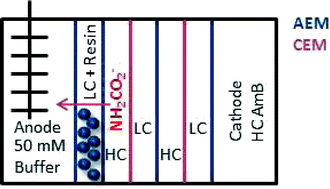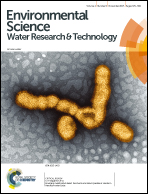Reducing nitrogen crossover in microbial reverse-electrodialysis cells by using adjacent anion exchange membranes and anion exchange resin†
Abstract
Microbial reverse electrodialysis cells (MRECs) combine power generation from salinity gradient energy using reverse electrodialysis (RED), with power generation from organic matter using a microbial fuel cell. Waste heat can be used to distill ammonium bicarbonate into high (HC) and low salt concentration (LC) solutions for use in the RED stack, but nitrogen crossover into the anode chamber must be minimized to avoid ammonia loses, and foster a healthy microbial community. To reduce nitrogen crossover, an additional low concentration (LC) chamber was inserted before the anode using an additional anion exchange membrane (AEM) next to another AEM, and filled with different amounts of anion or cation ion exchange resins. Addition of the extra AEM increased the ohmic resistance of the test RED stack from 103 Ω cm2 (1 AEM) to 295 Ω cm2 (2 AEMs). However, the use of the anion exchange resin decreased the solution resistance of the LC chamber by 74% (637 Ω cm2, no resin; 166 Ω cm2 with resin). Nitrogen crossover into the anode chamber was reduced by up to 97% using 50% of the chamber filled with an anion exchange resin compared to the control (no additional chamber). The added resistance contributed by the use of the additional LC chamber could be compensated for by using additional LC and HC membrane pairs in the RED stack.


 Please wait while we load your content...
Please wait while we load your content...